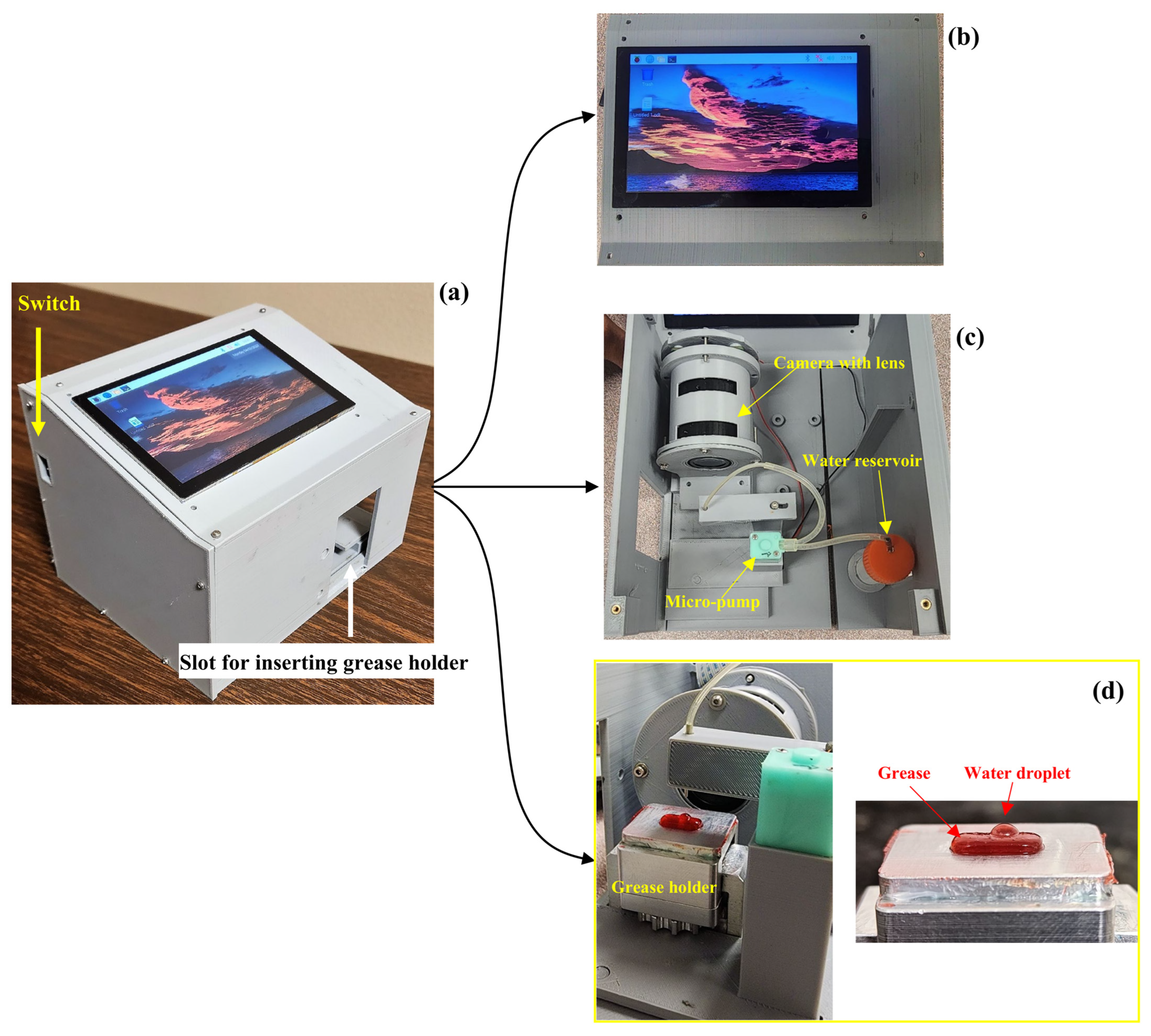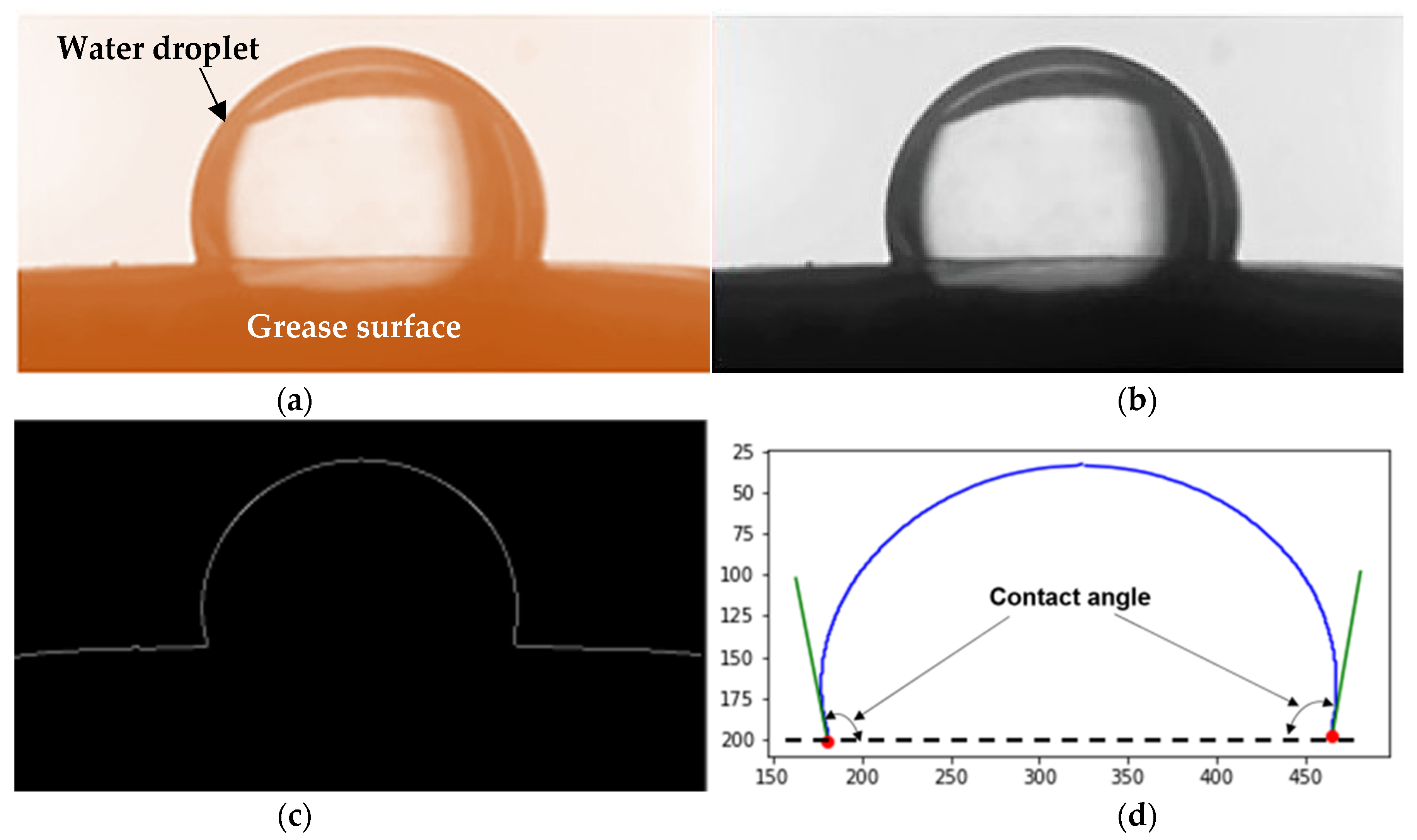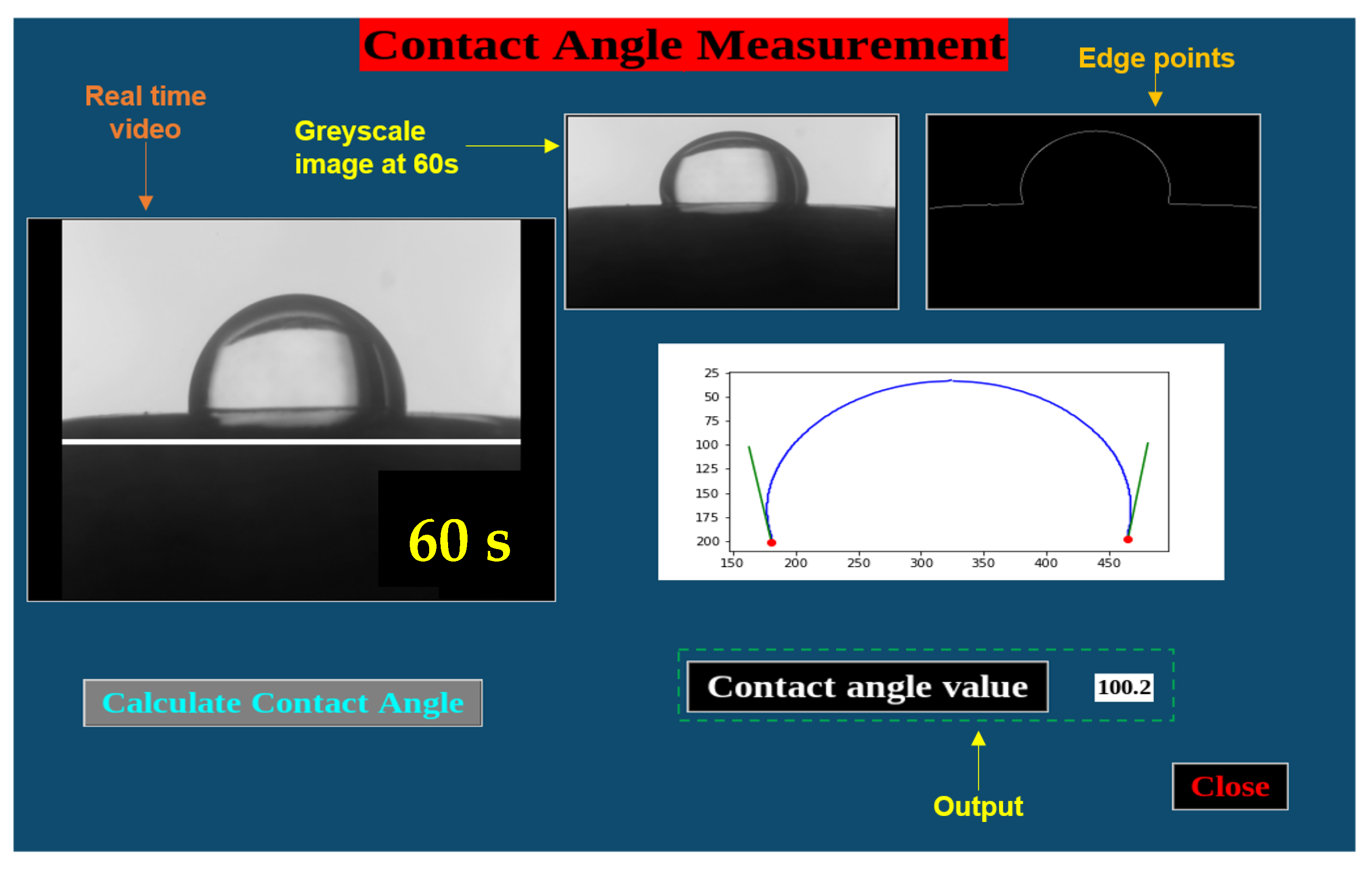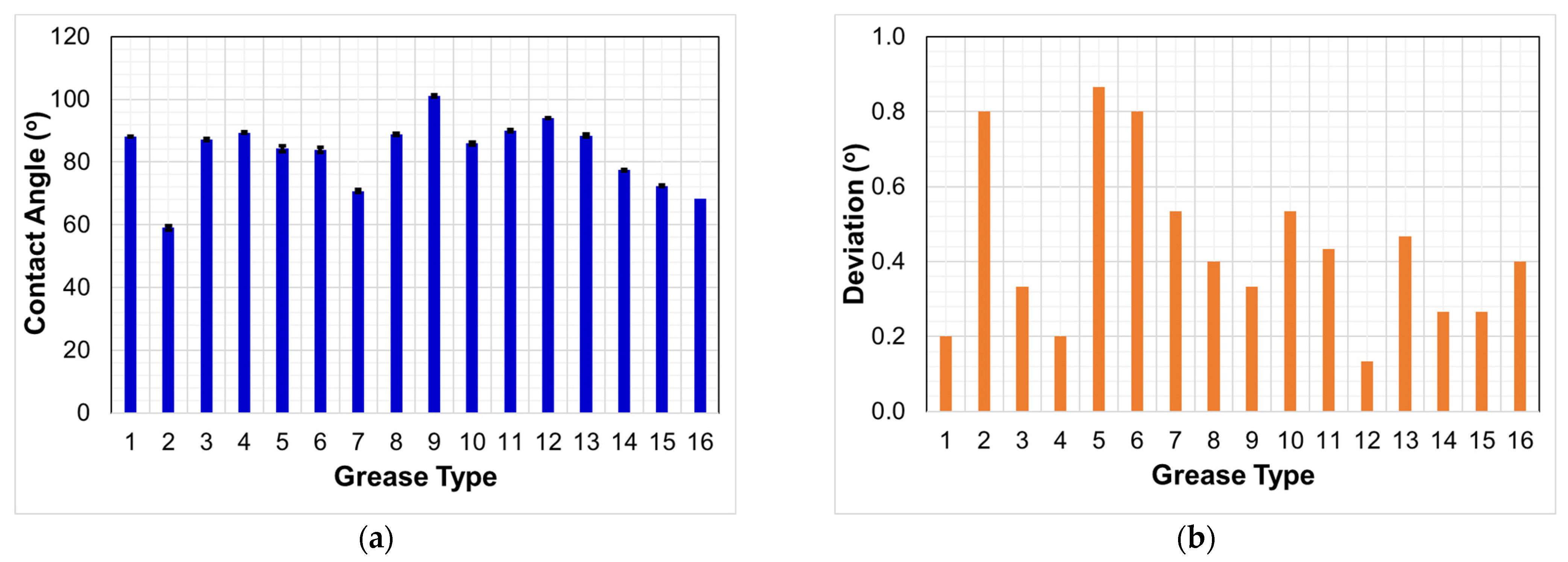The Standard for Assessing Water Resistance Properties of Lubricating Grease Using Contact Angle Measurements
Abstract
:1. Introduction
- DIN 51807-1 [18] (resistance of the lubricating grease to water) is a static water resistance test where a thin strip of grease on a glass strip is dipped in a test tube with water and heated for 3 h at 40 °C or 90 °C. After heating, the glass strip is visually inspected. An evaluation is made based on the scale established in the standard (0 = no change to 3 = major change). This approach is qualitative.
- ISO 11009:2000/ASTM D1264 [19,20] (standard test method for determining the water washout characteristics of lubricating greases) assesses the resistance capability of lubricating grease to water washout from a bearing operated at ~600 rpm, with an operating temperature of 38 °C and 79 °C. The standard mentions that this test is unsuitable for greases containing highly volatile components.
- ASTM D4049 [21] (standard test method for determining the resistance of lubricating grease to water spray) assesses the ability of grease to adhere to a surface when subjected to the impingement of a water spray. This test method suggests a correlation between the operating conditions of this test and water spray impingement in steel mill roll neck bearing service.
- ASTM D8022 [22] Wet roll stability test (standard test method for roll stability of lubricating grease in the presence of water) assesses the stability of grease within a rolling apparatus when exposed to water at lower shear and operated at 20–35 °C. The wet roll stability test result is the difference in the cone penetration values measured before and after working the grease.
- ASTM D7342 [23] Water stability test (standard test method for prolonged worked stability of lubricating grease in the presence of water) assesses the stability of grease in a standard grease worker when exposed to water. The rest of the procedure is the same as ASTM D8022.
2. Materials and Methods
- Step 1: The top of the grease holder is moved up by rotating the rotating part, creating a slot in the center to apply the grease.
- Step 2: 0.1–0.3 gms grease is taken for testing.
- Step 3: The grease sample is filled in the slot.
- Step 4: The excess grease is wiped off.
- Step 5: The top part is moved down, creating a projection of grease to be tested.
3. Results
4. Discussion
- The highest contact angle (~101°) indicating higher water resistance properties of the grease is observed for Grease type 9, with Lithium complex as a thickener, NLGI grade 2, and synthetic oil as a base oil with 220 cSt.
- The lowest contact angle is observed for Grease type 2, with Lithium as a thickener, NLGI grade 2, and bio-based oil as a base oil with 220 cSt. This indicates that the proper selection of grease thickener and base oil is necessary for achieving good water resistance properties. Thus, grease thickener and base oil type should be considered for improved water resistance properties.
- Comparing the ISO 460 mineral oil greases with NLGI 2 consistencies, the contact angle value is observed to be the highest for the CaS thickener. It is well known that grease with CaS as a thickener provides the best performance in the presence of water [8].
- Comparing grease types 1, 5, 14, 15, and 16, the contact angle values are observed to increase with a concurrent increase in the NLGI grease grades (see Figure 6).
- Comparing grease types 5 & 9 and 7 & 10, the contact angle values are observed to be high for grease with synthetic oil as the base oil. Comparing grease types 5 & 9 and 7 & 10, the contact angle values are observed to be high for grease with synthetic oil as the base oil. Synthetic base oils are generally susceptible to hydrolysis compared to mineral oil, i.e., synthetic base oils remain stable in damp environments as they do not emulsify when exposed to water [10,28]. Further, the saturation of water content in mineral oil is often about 200–300 ppm moisture, while for synthetic oil it can be close to 1000 ppm [10].
- Grease types 12 and 13 had the same grease composition but were from different companies. The difference in the contact angle values indicates that the chemistry followed for developing a grease, results in different water resistance properties of that grease.
4.1. Development of the Standard
4.2. ASTM Water Resistance Standard (ASTM D4049 and ASTM D1264)
Conclusions from Table 4
5. Conclusions
Author Contributions
Funding
Data Availability Statement
Conflicts of Interest
References
- Lugt, P.M. A review on grease lubrication in rolling bearings. Tribol. Trans. 2009, 52, 470–480. [Google Scholar] [CrossRef]
- Cyriac, F.; Lugt, P.M.; Bosman, R. Impact of water on the rheology of lubricating greases. Tribol. Trans. 2016, 59, 679–689. [Google Scholar] [CrossRef]
- Lijesh, K.P.; Khonsari, M.M. A Unified Treatment of Tribo-Components Degradation Using Thermodynamics Framework: A Review on Adhesive Wear. Entropy 2021, 23, 1329. [Google Scholar]
- Zhou, Y.; Bosman, R.; Lugt, P.M. On the shear stability of dry and water-contaminated calcium sulfonate complex lubricating greases. Tribol. Trans. 2019, 62, 626–634. [Google Scholar] [CrossRef]
- Authier, D.; Herman, A. Calcium Sulfonate Carbonate Greases: A Solution to Water Resistance. In Proceedings of the 25th Annual Elgi Meeting, Amsterdam, The Netherlands, 20–23 April 2013; pp. 19–35. [Google Scholar]
- Dittes, N.; Marklund, P.; Anders Pettersson, A. Mixing grease with water. In Proceedings of the 1st European Conference on Improvement in Bearing Technology through European Research Collaboration (iBETTER), Utrecht, The Netherlands, 23–24 February 2015; SKF Engineering and Research Center Nieuwegein: Utrecht, The Netherlands, 2015. [Google Scholar]
- Noria Corporation. Water in Oil Contamination. Machinery Lubrication. 2001. Available online: https://www.machinerylubrication.com/Read/192/water-contaminant-oil (accessed on 28 July 2023).
- Khonsari, M.M.; Lijesh, K.P.; Roger, A.M.; Raj, S. Evaluating Grease Degradation through Contact Angle Approach. Lubricants 2021, 9, 11. [Google Scholar] [CrossRef]
- Eachus, A.C. The trouble with water. Tribol. Lubr. Technol. 2005, 61, 32. [Google Scholar]
- Braun, M.J.; Hannon, W.M. Cavitation formation and modelling for fluid film bearings: A review. Proc. Inst. Mech. Eng. Part J J. Eng. Tribol. 2010, 224, 839–863. [Google Scholar] [CrossRef]
- Appleby, M.; Fred, K.C.; Li, D.; Jiang, Z. Oil debris and viscosity monitoring using ultrasonic and capacitance/inductance measurements. Lubr. Sci. 2013, 25, 507–524. [Google Scholar] [CrossRef]
- Ray, D.L.; Vincent, B.C.; Guirandenq, P.; Chene, J.; Aucouturier, M. Hydrogen embrittlement of a stainless ball bearing steel. Wear 1980, 65, 103–111. [Google Scholar] [CrossRef]
- Mistry, A. Performance of lubricating greases in the presence of water. In NLGI Spokesman—Including NLGI Annual Meeting—National Lubricating Grease Institute; National Lubricating Grease Institute: Kansas City, MO, USA, 2005; Volume 68, pp. 8–15. [Google Scholar]
- Lijesh, K.P.; Khonsari, M.M.; Roger, A.M. Assessment of water contamination on grease using the contact angle approach. Tribol. Lett. 2020, 68, 103. [Google Scholar] [CrossRef]
- Nagarkoti, A.S. Water resistance properties of grease–an outlook. In Proceedings of the NLGI-India 12th Lubricating Grease Conference, Panaji, India, 2–30 January 2010; pp. 28–30. [Google Scholar]
- Leckner, J. Water + Grease = Fatal Attraction? In Proceedings of the 25th ELGI Annual General Meeting, Amsterdam, The Netherlands, 20–23 April 2013; pp. 1–18. [Google Scholar]
- Li, J.; Cheng, S.; Zhao, W.; Baojie, W. The typical application of calcium sulfonate complex greases in steel mills. NLGI Spokesm. 2018, 82, 32–38. [Google Scholar]
- DIN 51807-1; Testing of Lubricants—Test of the Behaviour of Lubricating Greases in the Presence of Water–Part 1: Static Test. Deutsches Institut fur Normung E.V. (DIN): Berlin, Germany, 2020.
- DIN ISO 11009; Petroleum Products and Lubricants–Determination of Water Washout Characteristics of Lubricating Greases (ISO 11009:2000). American National Standards Institute (ANSI): Washington, DC, USA, 2019.
- ASTM D1264; Standard Test Method for Determining the Water Washout Characteristics of Lubricating Greases. ASTM International: West Conshohocken, PA, USA, 2018.
- ASTM D4049; Standard Test Method for Determining the Resistance of Lubricating Grease to Water Spray. ASTM International: West Conshohocken, PA, USA, 2020.
- ASTM D8022; Standard Test Method for Roll Stability of Lubricating Grease in Presence of Water (Wet Roll Stability Test). ASTM International: West Conshohocken, PA, USA, 2020.
- ASTM D7342; Standard Test Method for Prolonged Worked Stability of Lubricating Grease in Presence of Water (Water Stability Test). ASTM International: West Conshohocken, PA, USA, 2020.
- The Timken Company. Timken Tapered Roller Bearing Catalog; The Timken Company: North Canton, OH, USA, 2016. [Google Scholar]
- McGuire, N. Selecting lubricating greases: What you should know. Tribol. Lubr. Technol. 2017, 73, 38. [Google Scholar]
- Shen, Z.; Fei, G.; Xinxin, F.; Zhichen, S.; Haiyan, W. Effect of preparation process on elevated temperature tribological properties of composite polyurea grease. Ind. Lubr. Tribol. 2016, 68, 611–616. [Google Scholar] [CrossRef]
- Shah, R.; Lijesh, K.P.; Khonsari, M.M.; Anthony, S.; Shashank, B. Design and Development of an Innovative Instrument to Measure Consistency and Useful Life in Greases. Petro-Online. 2022. Available online: https://www.petro-online.com/article/measurement-and-testing/14/koehler-instrument-company/design-and-development-of-an-innovative-instrument-to-measure-consistency-and-useful-life-in-greases/3089 (accessed on 28 July 2023).
- Volvoline Company Website. Available online: https://www.valvolineglobal.com/en-eur/top-8-advantages-of-synthetic-oil-and-lubricants/ (accessed on 28 July 2023).






| Grease Type | NLGI Grades | Base Oil Type | Grease Thickeners | Base Oil Viscosity @ 40 °C cSt | Contact Angle (°) | ||
|---|---|---|---|---|---|---|---|
| Trial 1 | Trial 2 | Trial 3 | |||||
| 1 | 3 | Mineral | LiC | 220 | 88 | 88.4 | 87.9 |
| 2 | 2 | Bio-based oil | Li | 220 | 58.2 | 59.2 | 59.6 |
| 3 | 2 | Mineral | AlC | 226 | 86.8 | 87.4 | 87.2 |
| 4 | 2 | Mineral | CaS | 460 | 89.4 | 89.6 | 89.2 |
| 5 | 2 | Mineral | LiC | 220 | 83.4 | 85.4 | 84 |
| 6 | 2 | Mineral | LiC | 460 | 83 | 84.4 | 84 |
| 7 | 2 | Mineral | Poly Urea | 220 | 71.2 | 70.2 | 70.8 |
| 8 | 2 | Synthetic | LiC | 100 | 89.2 | 88.4 | 88.8 |
| 9 | 2 | Synthetic | LiC | 220 | 100.8 | 101.2 | 101.4 |
| 10 | 2 | Synthetic | Poly Urea | 220 | 84.4 | 86.6 | 86.8 |
| 11 | 2 | Synthetic | Silicone | 220 | 89.6 | 90.4 | 90.1 |
| 12 | 1.5 | Synthetic | LiC | 460 | 94.2 | 93.8 | 93.8 |
| 13 | 1.5 | Synthetic | LiC | 460 | 88.4 | 88.8 | 87.9 |
| 14 | 1 | Mineral | LiC | 220 | 77.8 | 77.2 | 77.4 |
| 15 | 0 | Mineral | LiC | 220 | 72.5 | 72.1 | 72.5 |
| 16 | 00 | Mineral | LiC | 220 | 67.8 | 68.4 | 68.4 |
| Grades | Contact Angle (°) | Water-Resistance Characterization |
|---|---|---|
| 1 | <60° | Very Poor |
| 2 | 60–70° | Poor |
| 3 | 70–80° | Average |
| 4 | 80–90° | Good |
| 5 | >90° | Excellent |
| Grease Type | NLGI Grades | Base Oil Type | Grease Thickeners | Base Oil Viscosity @ 40 °C cSt | Average Contact Angle Values (°) | Proposed Grades |
|---|---|---|---|---|---|---|
| 1 | 3 | Mineral | LiC | 220 | 88.1 | 4 |
| 2 | 2 | Bio-based oil | Li | 220 | 59 | 1 |
| 3 | 2 | Mineral | AlC | 226 | 87.13 | 4 |
| 4 | 2 | Mineral | CaS | 460 | 89.4 | 4 |
| 5 | 2 | Mineral | LiC | 220 | 84.27 | 4 |
| 6 | 2 | Mineral | LiC | 460 | 83.8 | 4 |
| 7 | 2 | Mineral | Poly Urea | 220 | 70.73 | 3 |
| 8 | 2 | Synthetic | LiC | 100 | 88.8 | 4 |
| 9 | 2 | Synthetic | LiC | 220 | 101.33 | 5 |
| 10 | 2 | Synthetic | Poly Urea | 220 | 85.93 | 4 |
| 11 | 2 | Synthetic | Silicone | 220 | 90.03 | 5 |
| 12 | 1.5 | Synthetic | LiC | 460 | 93.93 | 5 |
| 13 | 1.5 | Synthetic | LiC | 460 | 88.37 | 4 |
| 14 | 1 | Mineral | LiC | 220 | 77.47 | 3 |
| 15 | 00 | Mineral | AlC | 244 | 55.17 | 1 |
| 16 | 00 | Mineral | LiC | 220 | 68.2 | 2 |
| Grease Type | Average Contact Angle Values (°) | Proposed Grades | Water Washout, Loss wt%, | Water Spray Off, Loss wt%, |
|---|---|---|---|---|
| 1 | 88.1 | 4 | 5 | 10 |
| 2 | 59 | 1 | NA | NA |
| 3 | 87.13 | 4 | 5.78 | NA |
| 4 | 89.4 | 4 | NA | NA |
| 5 | 84.27 | 4 | 5 | 10 |
| 6 | 83.8 | 4 | NA | NA |
| 7 | 70.73 | 3 | 1.9 | NA |
| 8 | 88.8 | 4 | 6 | NA |
| 9 | 101.33 | 5 | 1.5 | NA |
| 10 | 85.93 | 4 | 7 | 26 |
| 11 | 90.03 | 5 | <1 | NA |
| 12 | 93.93 | 5 | <3 | 6.5 |
| 13 | 88.37 | 4 | 7 | NA |
| 14 | 77.47 | 3 | 8 | 15 |
| 15 | 55.17 | 1 | NA | NA |
| 16 | 68.2 | 2 | 37 | NA |
| Grades | Contact Angle (°) | Water Spray Off, Loss wt%, | Water Washout, Loss wt%, |
|---|---|---|---|
| 1 | <60° | - | - |
| 2 | 60–70° | >37 | - |
| 3 | 70–80° | >7 & <36 | >26 |
| 4 | 80–90° | >3 & <7 | >6.5 & <26 |
| 5 | >90° | <3 | <6.5 |
Disclaimer/Publisher’s Note: The statements, opinions and data contained in all publications are solely those of the individual author(s) and contributor(s) and not of MDPI and/or the editor(s). MDPI and/or the editor(s) disclaim responsibility for any injury to people or property resulting from any ideas, methods, instructions or products referred to in the content. |
© 2023 by the authors. Licensee MDPI, Basel, Switzerland. This article is an open access article distributed under the terms and conditions of the Creative Commons Attribution (CC BY) license (https://creativecommons.org/licenses/by/4.0/).
Share and Cite
Lijesh, K.; Miller, R.A.; Shah, R.; Shirvani, K.; Khonsari, M.M. The Standard for Assessing Water Resistance Properties of Lubricating Grease Using Contact Angle Measurements. Lubricants 2023, 11, 440. https://doi.org/10.3390/lubricants11100440
Lijesh K, Miller RA, Shah R, Shirvani K, Khonsari MM. The Standard for Assessing Water Resistance Properties of Lubricating Grease Using Contact Angle Measurements. Lubricants. 2023; 11(10):440. https://doi.org/10.3390/lubricants11100440
Chicago/Turabian StyleLijesh, Koottaparambil, Roger A. Miller, Raj Shah, Khosro Shirvani, and Michael M. Khonsari. 2023. "The Standard for Assessing Water Resistance Properties of Lubricating Grease Using Contact Angle Measurements" Lubricants 11, no. 10: 440. https://doi.org/10.3390/lubricants11100440
APA StyleLijesh, K., Miller, R. A., Shah, R., Shirvani, K., & Khonsari, M. M. (2023). The Standard for Assessing Water Resistance Properties of Lubricating Grease Using Contact Angle Measurements. Lubricants, 11(10), 440. https://doi.org/10.3390/lubricants11100440







